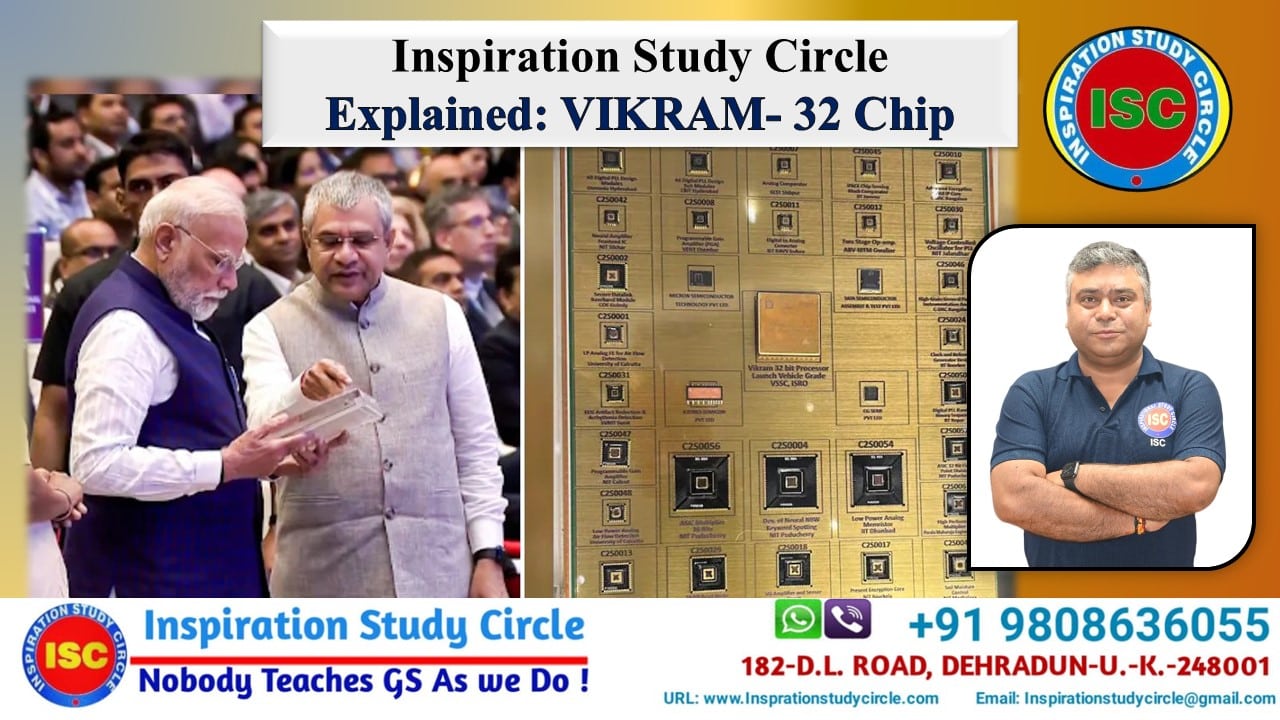
The Viksit Bharat – Guarantee for Rozgar and Ajeevika Mission (Gramin) Bill, 2025
The Viksit Bharat – Guarantee for Rozgar and Ajeevika Mission (Gramin) Bill, 2025 Table of Contents The Viksit Bharat – Guarantee
Union Information and Broadcasting Minister Ashwini Vaishnaw recently unveiled India’s first indigenously developed 32-bit processor called VIKRAM-32. The minister presented the microchip to Prime Minister Narendra Modi at the inauguration of the Semicon India 2025 conference. VIKRAM-32 microchip has been developed by the Indian Space Research Organisation (ISRO)’s Semiconductor Laboratory (SCL), Chandigarh. It is said to be specifically designed to withstand extreme conditions of rocket launches and space environments.
VIKRAM-32 is the successor to the VIKRAM1601, a 16-bit microprocessor that has powered ISRO’s launch vehicles since 2009. The VIKRAM-32 (officially Vikram 3201) is India’s first indigenously designed and manufactured 32-bit microprocessor. Developed by the Indian Space Research Organisation (ISRO).
It was developed by the Vikram Sarabhai Space Centre, a part of ISRO, and fabricated at the Semiconductor Laboratory in Mohali. It is intended for use in rockets, satellites, and other high-reliability systems.
The purpose of the VIKRAM-32 microprocessor is to power future Indian Space Research Organisation (ISRO) missions, including rockets and satellites. The 32-bit, space-grade chip is an indigenous (Made-in-India) replacement for older, imported systems, and is designed to withstand the extreme conditions of space, including temperature fluctuations and radiation.

The Vikram-32 microprocessor, developed by the Indian Space Research Organisation (ISRO), has applications primarily in space technology; however, its rugged and reliable design makes it suitable for other high-stakes domains as well.
Space applications:
Terrestrial applications:
The extreme reliability required for space missions makes Vikram-32 suitable for other fields where robust performance under challenging conditions is critical.
Broader impacts:
The development of VIKRAM-32 is a major milestone for India’s push for self-reliance under its “Atmanirbhar Bharat” initiative and the India Semiconductor Mission. Its creation:
The earlier VIKRAM-1601 served ISRO well, but as missions get more complex, the need for higher precision and better computing power has grown. The shift from 16-bit to 32-bit architecture enables the new processor to handle larger amounts of data, support modern software, and perform faster and more accurate calculations. This makes it better suited for next-generation launch vehicles and space missions. The key features of VIKRAM-32 are:
Beyond rockets, processors like VIKRAM-32 can also find applications in defense, aviation, and industrial control systems, where reliability under harsh conditions is crucial. More importantly, the chip highlights India’s ability to design, build, and qualify high-end electronics within the country, reducing dependence on foreign suppliers.
The VIKRAM-32 marks a major milestone in India’s journey toward technological self-reliance. By replacing the older VIKRAM-1601, it brings more power, precision, and flexibility to ISRO’s missions. As it gets deployed in future launch vehicles and space systems, it will play a key role in supporting India’s expanding ambitions in space exploration.
The Vikram-32 microprocessor is a strategic milestone that sets India up for greater self-reliance, technological leadership, and enhanced capabilities in its space, defense, and semiconductor industries. Its future significance goes beyond its immediate function in ISRO’s missions.
Inspiration Study Circle provides a wide variety of information on the tips of your fingers. You can easily access us on WhatsApp, Facebook, and Instagram. Our website is frequently updated for the candidates’ benefit.

The Viksit Bharat – Guarantee for Rozgar and Ajeevika Mission (Gramin) Bill, 2025 Table of Contents The Viksit Bharat – Guarantee

How to Prepare for UKPCS 2026 in Six Months Table of Contents ISC- How to Prepare for UKPCS 2026 in

UKPSC Upper and Lower PCS Combined Batch for 2026-2027 Table of Contents Unlocking Uttarakhand’s Civil Services: The Power of UKPCS

Explained: Russian President Vladimir Putin’s State Visit to India Table of Contents Russian President Vladimir Putin conducted a state visit

UPPSC Upper PCS 2025: Mains Test Series and Answer Writing Table of Contents Inspiration Study Circle- Dehradun The UPPSC PCS

The Sanchar Saathi App Table of Contents The Sanchar Saathi app is a security and user-protection platform developed by India’s Department of Telecommunications (DoT) to help users manage mobile connections, report fraud, and locate lost phones